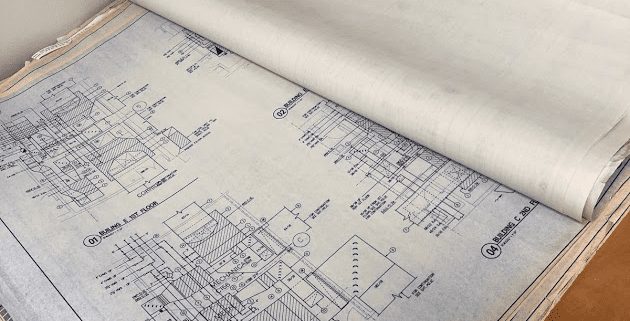Plan and Spec: Explained
As someone working in the design and construction of MEP in commercial buildings, you may have heard the term plan and spec. For example, you might see a specific job described as a plan and spec job. Or if we’re talking about a new project opportunity, it may be defined as a plan and spec bid. The term is common in the industry, but if you’re just starting out, you might not be entirely sure of the meaning.
What does Plan and Spec Mean?
Plan and spec is a method of commercial construction project delivery where design drawings (or plans) are created along with written specifications (or specs) to further describe the equipment and parts shown in the drawings.
The plan and spec method goes by many similar names, like planning and specifications, plan and specifications, plan-spec, or the abbreviated P&S. There are other names for the same method, like design-bid or design-bid-build. These terms are used interchangeably, so you might see us use all different versions here in this article. But don’t be confused – they mean the same thing.
Before a construction project begins, the Owner must decide on the project delivery approach. Plan and spec is the most traditional approach, while newer methods like design-build have been gaining traction. Each project delivery method has its own set of benefits and challenges. The main difference in methodologies is the alignment of team roles and the timing of construction.
A Typical Plan and Spec Project
Although no project is “typical,” most plan and spec projects follow a similar team organization and set project phases.
In a P&S project, the Owner will seek out two teams of professionals:
- Design Team – The design team usually includes MEP engineers, civil & structural engineers, architects, and other consultants.
- Construction Team – The construction team is comprised of a general contractor, and multiple subcontractors, such as a mechanical contractor.
The Owner may seek out additional consultants independent from the design and construction teams. For example, the Owner may decide to hire a commissioning agent to review the construction work. Or perhaps they may hire a third-party design review team before giving the thumbs-up on the final designs.
Team Leadership and Communication
Each team is led by one of the subsidiary disciplines. This consultant is generally referred to as prime, or the primary consultant and leader of the design or construction team.
Traditionally, the architect is prime for the design team, and the general contractor is prime for the construction team.
But that’s not a strict rule. Depending on the nature of the project, different disciplines may be the prime consultant. For example, the MEP engineer could be prime while the architect is a consultant.
The two sets of teams are hired and managed independently from one another. The prime consultant on each team serves as the single point of contact between team members and the Owner.
As a result, the prime has two project responsibilities: they are responsible for their disciplinary work, as well as overall project management of the other disciplines and communication with the Owner.
Team Responsibilities
In a plan & spec project, the delineation of responsibilities is quite clear.
The design team is responsible for producing a complete set of construction documents, which the construction team uses them to build the project.
Project Phases
When using the plan and spec delivery method, the construction does not start until the construction documents have been issued by the design team. That means there are two principal phases of a plan & spec project: the design phase and the construction phase.
Within each primary project phase, there are minor project phases. For example, the design team will have key project milestones broken into design phases with names like schematic design, design development, and construction design.
Pros & Cons of Plan and Spec
As a delivery method, plan & spec offers both advantages and disadvantages.
Advantages of Plan and Spec:
One of the biggest reasons Owners choose Plan & Spec is because construction costs are more defined. After the design is completed, the Owner can send out the construction documents for bid. Put more simply, the Owner will ask potential construction teams to provide a price for the building as designed. Knowing the cost of construction before breaking ground limits the financial exposure of the Owner. Or, at the very least, it helps them understand the price to build the facility. In short, plan and spec is a methodical approach that allows the Owner to stage costs and risks.
Plan & spec is also a logical choice for several other reasons:
- In-Depth Design & Analysis – For projects that require more time and attention from the engineering team, plan and spec is advantageous. Because construction happens separately, the project timeline typically allows for deeper thinking and additional analysis to perfect the design.
- Design Collaboration – Plan/spec projects allow for enhanced collaboration amongst all the design disciplines. Working together, individual designers can seek out synergies for an optimal design.
- Creative Problem-Solving – Without construction teams waiting on an answer, the design teams are not limited in solutions to design problems. Flexibility exists to change the design approach entirely if it is warranted.
- Specialty Projects – If the project is full of many “firsts” or extra architectural challenges, plan and spec is best. The team can tackle more challenging designs, like a net-zero building or an intricate architectural design.
Disadvantages of Plan and Spec:
Every project delivery method has its downfalls, and plan-spec jobs are no different.
Most construction teams could talk your ear off about why plan & spec is an inferior delivery method. To be completely transparent, the reason for this can be traced back to revenue. Plan and spec projects are not always financially beneficial to construction teams. Why? If they sell the Owner on the job at a specific price, there is immense pressure to ensure that they are profitable at that fixed price. For every problem that delays construction or requires extra time, the gross profit for the contractor shrinks. So, it makes sense for a general contractor to recommend a delivery method that makes them more money, even if it is not necessarily the best fit for the project.
Still, we recognize there are some disadvantages to plan & spec. They include:
- Length of Construction – Depending on complexity, plan and spec commercial construction projects can take years to build. A “quick” plan & spec project could be 1.5 years, while some projects can stretch to five years or longer. So, plan & spec may not suit a construction project that is intended to be a fast build.
- Troubleshooting Construction Problems – No matter how good the design, there will inevitably be questions, changes, and problems once construction begins. Although all teams strive to get along, the Owner will want to know which party caused the problem. This can result in disputes amongst teams.
- Construction Quality for Low Bid – Unfortunately, many Owners opt to hire the construction team at the lowest price. Although the lowest cost doesn’t always equal the least quality, it often does. General contractors desperate to win work will bid at the bottom dollar, and then hire the most affordable subcontractors they can find. As a result, the building may not operate as the design team intended.
Plan and Spec Projects from RWB Consulting Engineers
RWB is known for our uncompromising quality on plan & spec projects. For over thirty years, we have been delivering excellence in mechanical, electrical, and plumbing design on P&S projects. Our experience, combined with our commitment to ongoing learning, makes RWB the best choice for commercial building design projects in Texas.




